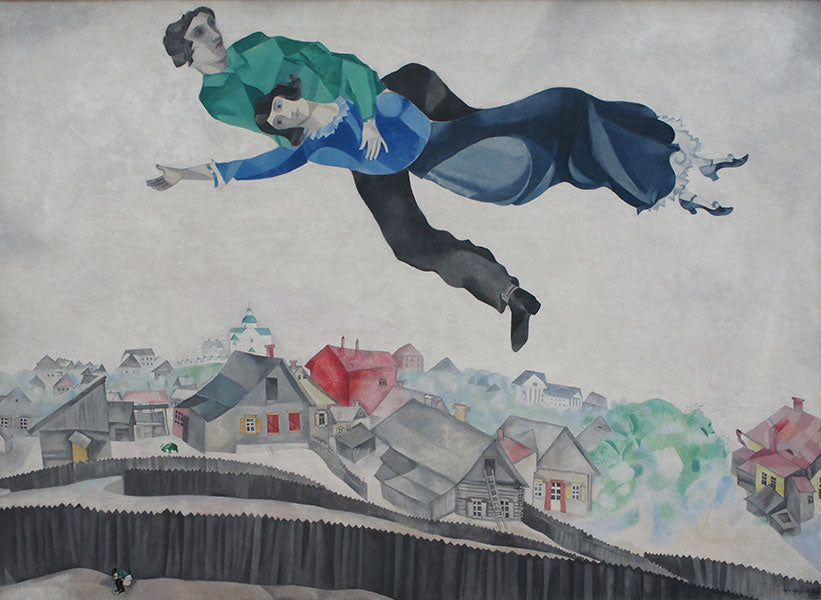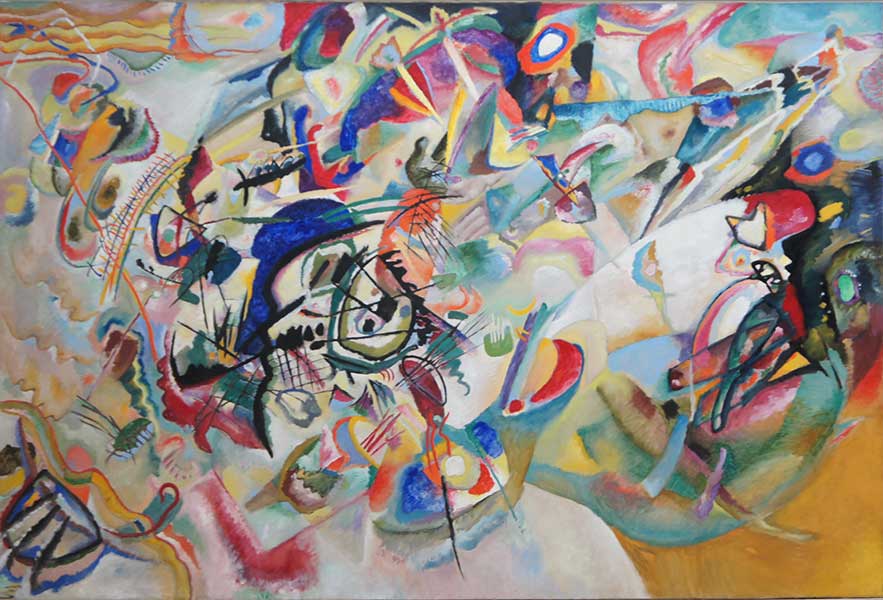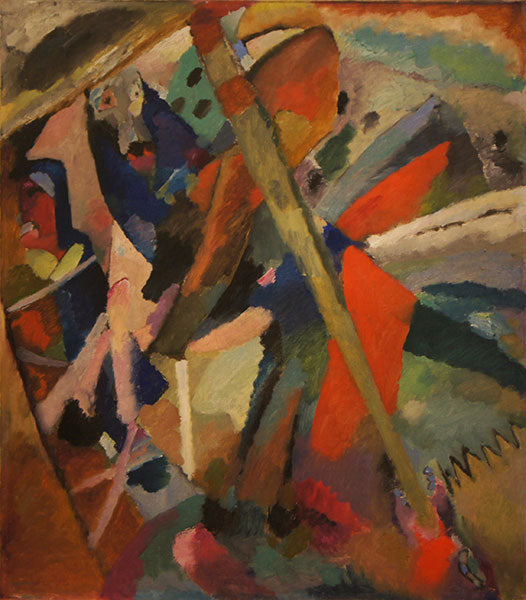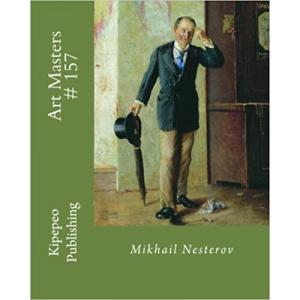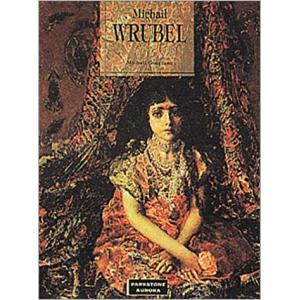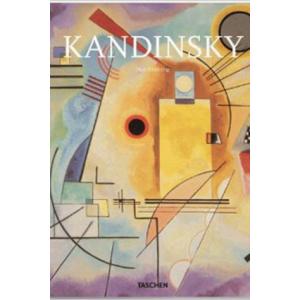Exploring a World Beyond: The Russian Symbolist Painters
by Cathy Locke
Symbolism in art has been used by painters for centuries and has been refined over the years to become an art form unto itself. By the late nineteenth and early twentieth centuries, Symbolism had become both an intellectual and an artistic movement throughout Europe and Russia, taking on a more mystical nature and incorporating the intuitive qualities of music, especially in literature and painting.
One of the most renowned Russian poets of the Symbolist movement was Alexander Blok (1880–1921), whose work became so influential that the entire Silver Age of Russian Poetry is often referred to as the “Age of Blok”. The poet's early writings were very musical and rich in sound, while his later work introduced rhythmic patterns and uneven beats.
Russian Symbolist Painters
In the world of fine art, the Russian Symbolist movement lasted approximately 20 years and spanned two generations of painters: the first generation from 1890 to 1900 and the second generation from around 1900 to 1910. The movement actually continued to develop into a third generation of artists, who worked well into the second decade of the twentieth century. The most notable artists of the first generation were Alexandre Benois (1870-1960) and Konstantin Somov (1869 –1939). Painting was purely an aesthetic experience for these artists, as they worked toward creating a mood or emotion through their use of color and traditional elements of Symbolism. Two important painters of the Symbolist Movement whose work spanned the first two generations were Mikhail Vrubel (1856-1910) and Mikhail Nesterov (1863-1942). These two painters were the first to incorporate mystical themes, which later became the trademark of the second and third generations of Russian Symbolist painters. It is important to note that in 2007, Somov's landscape The Rainbow (1927) was sold at Christie's for $7.33 million (USD), a record amount for Russian artwork sold at an auction.
Mikhail Vrubel
The body of work by Mikhail Vrubel made him the most famous of all Russian Symbolist painters. Although he was only loosely associated with the second generation of Symbolist painters, Vrubel shared a common ground with them, especially with his concentration on supernatural elements in his art. Mystical aspects began taking on an increasing significance in Vrubel's work as his paintings maintained a very strong link with the intuitive world outside the frame. In this way, Vrubel was breaking from the first generation of Russian Symbolist painters whose work lacked a mystical connection. Inspired by Lermontov’s poem The Demon, Vrubel began a long exploration of painting demons that brought him notoriety. The word “demon” means “soul” in Greek and thus, for Vrubel, these demon paintings were the personal expression of his inner soul struggle. Vrubel described his 1890 painting, Demon Seated, as follows:
A half-naked, winged, young, moody and thoughtful figure sits, hugging his knees against the sunset and looks at a flowering field, where branches rotting under flowers stretch.
Here, Vrubel poses questions of good and evil, putting forward his ideal of a heroic personality as he saw it: “a rebel, unwilling to accept the commonplace and unjust nature of reality, tragically alone.” Vrubel considered a “demon” to be the soul of a lonely man, reflecting perhaps, that he himself was also a very lonely man.
In Vrubel’s painting, Morning, the artist developed what became the typical cool color palette for the second generation of Russian Symbolist painters – blues, violets, greens, and grays. He presents a world that is not of our reality, but one that has mystical qualities, a feeling of the unknown. Vrubel also used the motive of movement, which became an important theme of the Symbolist painters. Pattern and value create a rhythmic movement throughout this painting, which reflects what the Symbolist poets were already doing by incorporating rhythmic beats into their writing. The symbol of water refers to the unconscious mind, the world of the unknown. Here, Vrubel has created a world where maidens pop up throughout the painting and flowers flow unconnected to any roots, allowing the viewer to float from one element to the next.
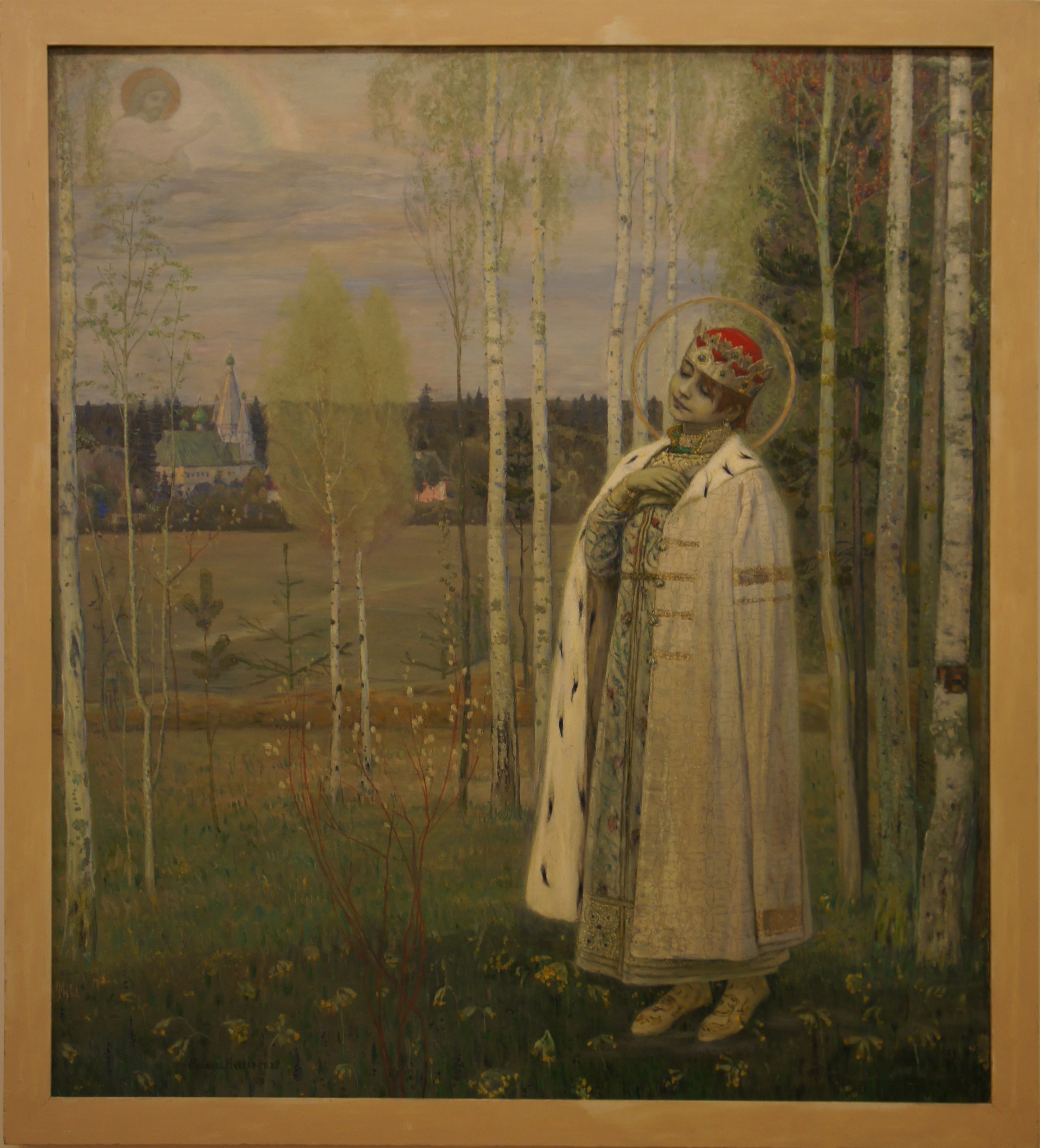
Mikhail Nesterov (1863-1942), “Murdered Prince Dmitrii,” 1899
Mikhail Nesterov
Both Vrubel and Nesterov developed a series of paintings based on Russian fairy tales, which became very popular with the Russian people. Nesterov was especially interested in the religious life of old Russia and began exploring religious fables in his search for the Russian religious ideal. The artist portrays the union between a soul absorbed in spiritual contemplation and the secret nature of untouched civilization. In Murdered Prince Dmitrii, Nesterov presents a humble prayer offered by the meek and ardently soul-seeking Prince, touching his heart and looking inward. Nesterov’s work has a quiet, soft presence to it. Using a primarily cool color palette the artist creates a sense of the mystic traveling through time, looking into the world of the unseen. It is important to note that after the 1917 Revolution, the Bolsheviks banned religious art, forcing Nesterov to paint mostly portraits.
The Blue Rose Movement
The phase involving the second generation of Russian Symbolist painters is referred to as the Blue Rose Movement, and was most active in Moscow from 1904 to 1908. These artists were not only known for their contribution to Russian Symbolism, but also for the very evolution of modern Russian painting. The name “Blue Rose” comes from the title of their one and only group exhibition which took place in Moscow over a two-month period in the spring of 1907. Visitors to the exhibition were greeted with walls covered in dark gray material upon which the paintings were hung, the floor was carpeted throughout, and the scent of hyacinths, lilies and daffodils was in the air as a string quartet played throughout the rooms. The art critic Makovsky wrote this review about the exhibit:
The Blue Rose is a beautiful exhibition, a chapel. For the very few. Light. Quiet. And the pictures are like prayers. When you enter this small chapel, you feel at once that the Blue Rose is not only a hothouse flower, but also a spring flower of mystical love…Their effect is not outward, physical, but psychological… Narrative is absent, precision of imagery is rejected.
The Blue Rose group consisted of sixteen artists, of which the foremost members had been in close contact for several years before this exhibition. By 1900, the majority of the members were attending the Moscow Institute of Painting and had seen several exhibitions of Mikhail Vrubel’s work. The artists who were particularly close were Anatolii Arapov, Nikolai Feofilaktov, Pavel Kuznetsov, Nikolai Sapunov, Martiros Saryan, Sergei Sudeikin and Petr Utkin. The leader of the group, Pavel Kuznetsov (1878-1968), was very good friends with Petr Utkin (1877-1943). They were both students of Viktor Borisov-Musatov (1870-1905) who first introduced them to Symbolism, and later joined their group. Kuznetsov was also a student of Valentin Serov (1865-1911), who introduced him to Impressionism. In May 1904, Kuznetesov and Utkin organized an exhibition they called Crimson Rose. This exhibit included their work as well as work by Borisov-Musatov and Mikhail Vrubel. Wassily Kandinsky (1866-1944) also contributed paintings to a few of the Blue Rose exhibitions in Moscow, between 1906 and 1910. Conceptually, the second generation of Russian Symbolist painters used art as a vehicle to reach the “other shore” or the “essence” instead of a mere exercise in a particular aesthetic medium, which was the premise behind the first generation of Russian Symbolists. The youthful energy and the desire to experiment possessed by the Blue Rose artists naturally led them to disregard orthodox taste. The art critic Nikolai Tarovaty wrote of their work:
An intoxicating vision beckons you into a world of ethereality and vague outlines. Dreams in azure of pale blue and dull, serene tones, trembling, unearthly silhouettes, transparent stalks of mystical flowers fanned by the light of dawn – and over all the haze of the unspoken, of that which can be fathomed only by vague presentiment.
Words such as “the light of dawn”, “presentiment” and “azure” were an integral part of the Symbolists’ vocabulary. The very name “Blue Rose” was in keeping with the ideals of these Symbolist painters for whom the color blue was a symbol of the ulterior world, a higher spiritual reality. The term ‘blue rose’ had first been used in German Symbolist literature to draw parallels to “the delicate female forms that are as supple as flowers”. At the time, a blue rose was non-existent which embraced the whole concept of a further dimension of spirituality. The Blue Rose paintings are characterized by their dream-like, contemplative quality within a context of introspection and an exploration of the spiritual nature of life. The primary aim of the artists was the transcendence of mundane reality, a communication with the beyond or the absolute, which they achieved through the use of certain symbols such as women, babies, fountains and rainbows. Color was also a very important element to these artists, who rejected the warm colors of life and passion in favor of what the French Symbolist, Maurice Denis (1870-1943), once described as the “illusive distances of cobalt or emerald”. Mikhail Vrubel’s striking use of blue, mauve and gray tones served to influence the Blue Rose artists which Symbolist writers referred to as the “poison of Vrubel’s green-mauve lilac.”
Thus, the limited palette of the Blue Rose painters consisted of the subdued colors of blues, grays and greens - the cool area of the spectrum – which they employed for obvious psychological appeal. In The Pool by Borisov-Musatov, for example, the painting has no sky, but its analogous blue color palette illuminates the entire painting. The ladies are portrayed in a state of mystic detachment - one glances downward toward the pool, while the other looks upward toward the sky. The artist submerges the viewer into a reflective world by mirroring the objects around the pond in the water. Borisov-Musatov's use of tempera paint reveals the grainy texture of the canvas, giving the painting the appearance of a tapestry. The artist suffered from a serious spinal injury and one can perhaps assume that in this painting, Borisov-Musatov was reflecting on life itself, since he died two years after the painting was finished.
Themes of Eternity
The symbol of eternal motherhood was often used in the Blue Rose paintings to symbolize an endless cycle of birth and rebirth. In Kuznetsov’s painting Morning. A New Man is Born, all signs of a visible reality dissolve; instead we enter into an intuitive place of dreams. The fountain symbolizes the mystical cycle of life, endowed with the spirit of all that exists, represented by the ornamental pattern of the artist's brushstrokes which flow downward like musical notes, integrating the fountain spray with the tree branches. Kuznetsov has placed a female alongside the fountain, the embodiment of one of Symbolism's central themes of eternal femininity. Years later, Nikolai Kalmakov (1873-1955) developed the theme further in his 1917 painting, Artemis and the Sleeping Endymion, where we again see the use of water and the female form as symbols of eternal femininity, but this was the first time erotic themes were ever featured in Russian art. In Kalmakov's painting, a man and a woman are intertwined within a circle to symbolize the cycles of life. Animals and animal patterns reinforce the primal nature of man and woman, and the artist uses the motive of rhythm to further enhance the symbolism of life. It is important to note, that this painting was commissioned by Prince Felix Yusupov (1887-1967), who is best known for the murder of Rasputin and whose family was richer than the Czars.

The Painting Revolution
The success of the Blue Rose artists and their exhibition was greatly enhanced by the financial support of bohemian patron Nikolai Ryabushinsky (1876-1951), who also published a luxurious Symbolist review called The Golden Fleece. One article in particular, Painting and Revolution by D. Imgardt (a name believed to be a pseudonym) was of vital significance not only in context to the Blue Rose Group but also to modern painting in general. The article discussed many of the same theories that Wassily Kandinsky would write about a few years later.
New artists will be true prophets and priests – the heralds of the Universal Soul’s inspirations. With a language of phantoms, dreams, colors and sounds they will begin to prophesy where positive scientific knowledge will lapse helplessly into silence… The particular sphere of painting is the color tone just as the musical tone is that of music … in music only the musical tone is necessary and important. The same with painting … It is consolation to learn that there exist certain young artist who have even gone further and who, in their inspired enlightenment, alien to any kind of literariness or preconceived philosophical ideas, have advanced as far as unconscious musicality…
In Imgardt's article, he touches on two relevant issues dealing with the aesthetics of the Blue Rose group: visual music and sound painting. In their work, you can see the development of “rhythmically” in the context of both themes and the use of dynamic line work. They believed that the rhythm of line maintains a direct connection with the world beyond the painting. For the Blue Rose artists, the very essence of real life was movement and, therefore, rhythm, so consequently the more musical or rhythmic the work of art, the closer it was to the absolute. It is important to note that many believed “D. Imgardt” was actually Wassily Kandinsky.
The Third Generation of Russian Symbolist Painters: Development of Sound Painting and Abstract Art
The painting, Birth of Venus (1912) by Nikolai Milioti (1874-1962), marked the beginning of the development of abstract painting, along with numerous similarities to Wassily Kandinsky’s work of the same time period. In his painting, Milioti creates a rhythmic pattern through the dynamic use of line which became known as ”sound painting”. Kandinsky, who was given credit for being the pioneer of abstract art, created a series of these sound paintings, which he titled Compositions. In this series, Kandinsky reduces the busy streets of Moscow into line and abstract form, creating uneven beats of poetry on the canvas. In Kandinsky’s Composition VII, painted a year after Milioti’s Birth of Venus, we see many similarities in their color palettes as well as their mark making. Kandinsky was also famous for his essays on Spirituality in Art, where he describes the necessity of the artist to seek an inner mystical quest.
The Birth of the Russian Avante-Garde
By neglecting and even distorting form, the Blue Rose artists liberated art from the rigid demands of Realism. Their work injected Russian painting with a new form of dynamism in their compositions, which later became the hallmark of the Russian Avant-Garde artists. By abstracting reality, the Blue Rose artists reduced the importance of the concrete object to a bare minimum. Color and line became an expressive force unprecedented in the history of Russian painting as the loss of “objectness” was countered by an increase in philosophical and mystical value in their work. It was in their “internalization”, their transmutation of the object rather than in their rejection of it, that the Blue Rose artists remained profoundly Symbolist while maintaining a direct link with the future achievement of the Russian avant-garde.*
About the Author
Cathy Locke is an award-winning fine art painter, professor, and published writer, specializing in Russian art of the 19th and 20th centuries. She is the editor of Musings-on-Art.org.
Cathy’s artwork: www.cathylocke.com
Resources:
* “The Blue Rose: Russian Symbolism in Art” by John E. Bowlt
“Russian Art, 1875-1975: A Collection of Essays” by John E. Bowlt
The Tretyakov Gallery website: http://www.tretyakovgallery.ru/en











